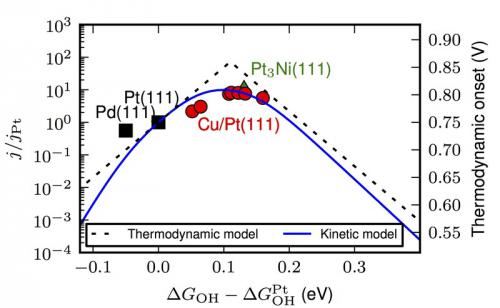Activity for the oxygen reduction reaction as function of the formation free energy of OH relative to Pt. The kinetic current density from model (solid blue line) and experiment (points) have been normalized to the current density on Pt(111) to be comparable to the trend in thermodynamic onset potential (dashed line).
The oxygen reduction reaction (ORR) has been a subject of major interest in electrochemistry because it is the main source of kinetic losses in low temperature PEM fuel cells. Research has focused on ways to reduce or eliminate the use of Pt required in fuel cells, and it has been realized that ORR activity is improved on materials that bind OH about 0.1 eV weaker than Pt. A thermodynamic analysis based on density functional theory explains this optimum as a tradeoff between removal of OH on strong binding materials such as Pt, and O2 activation on weak binding materials such as Au. In contrast, kinetic experiments on Pt point towards the first electron transfer to O2 being rate-determining, suggesting O2 activation rather than OH removal is limiting ORR activity.
Here we combine previously published activation energies calculated by density functional theory, with solvent reorganization timescales at the Pt-water interface calculated using molecular dynamics simulations in order to construct a micro-kinetic model for ORR on Pt. The model captures the 60 mV/decade tafel slope and the reaction order of 1 with respect to O2 on Pt(111) in non-adsorbing electrolytes, thereby reproducing kinetic experiments. We find the adsorption of O2 has kinetic rate control and the reduction of OH to H2O has thermodynamic rate control. The first property is essential to understand the tafel slope and reaction order, while the latter property is required to understand the increase in activity when OH binding is weakened.
Using published Brønsted-Evans-Polanyi and scaling relations, the kinetic model may be generalized with the OH (or O) formation energy as a descriptor for the ORR activity. As OH binding is weakened, the ORR activity initially increases as the thermodynamic rate control of OH removal diminishes until the point where OH binding becomes too weak to activate O2 through the formation of OOH, which has kinetic rate control on weak binding materials. Our Sabatier analysis reveals a close correspondence between the kinetic activity volcano and the “potential limiting” volcano derived from the thermodynamic analysis. The correspondence depends on cancellation of the timescales for solvent reorganization present in the steps with kinetic rate control on both sides of the Sabatier volcano.

